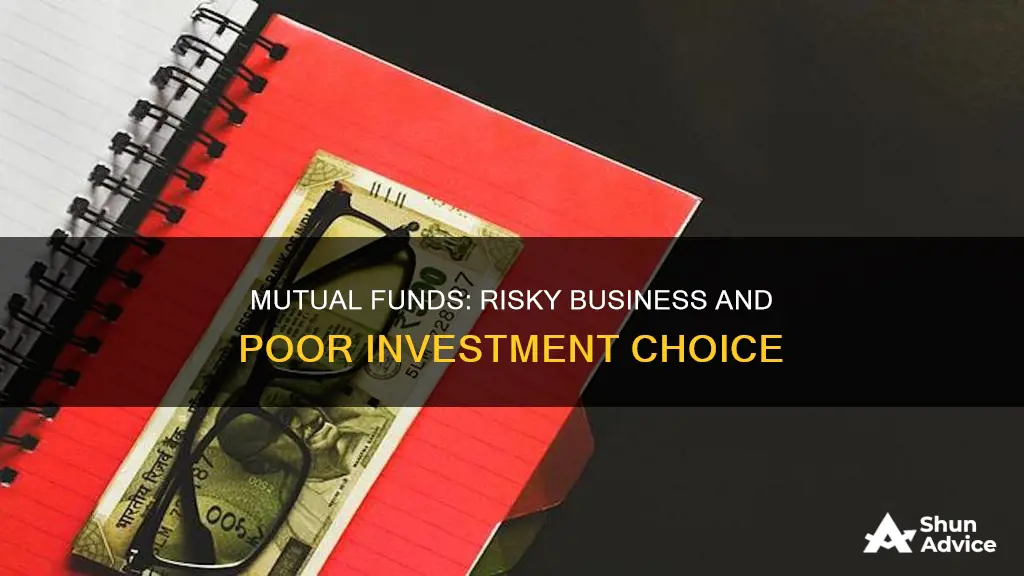
Mutual funds are actively managed investments, meaning a portfolio management team makes decisions about what to buy and sell. This results in high trading commissions, which eat into portfolio returns. Mutual funds also charge high fees for active trading, management, and other administrative costs. These fees are charged to your portfolio even in years when investments underperform or the stock market return is negative. While mutual funds are a safe investment, they are not always the best choice for investors due to these high fees.

High fees
For example, an investor who contributes $6,000 annually to a Tax-Free Savings Account (TFSA) for 35 years with an average rate of return of 10% would see their portfolio grow to $1,731,656 if they used a robo-advisor with a 0.50% management fee. However, if they invested in a mutual fund with a 3% management fee, their portfolio would only be worth $951,540—a difference of over $780,000.
In addition to management fees, mutual funds often charge sales charges or load fees when investors buy or sell shares of the fund. These fees can range from 2% to 4% and further eat into investment returns. Some funds also charge 12b-1 fees, which are advertising fees paid at the time of sale or purchase. These fees can add up quickly and significantly impact the overall profitability of investing in mutual funds.
The high fees associated with mutual funds are particularly problematic because they can outweigh the potential returns. Studies have shown that the majority of portfolio managers do not beat their benchmark stock index once their fees are applied. As a result, investors may find that they would have been better off investing in broad-market securities or exchange-traded funds (ETFs), which offer lower costs and greater flexibility.
It is worth noting that not all mutual funds have prohibitively high fees, and some may offer relatively low expense ratios. However, it is crucial for investors to carefully research the fees associated with any mutual fund before investing to ensure they are making an informed decision.
Unlocking Opportunities: Investing in VC Funds
You may want to see also

Lack of control
Mutual funds are actively managed investments, meaning that a portfolio management team makes decisions about what to buy and sell. This means that investors lack control over their investments. Every time a trade is made, investors pay trading commissions, which eat into their portfolio returns.
No one can time the market, and study after study shows that trying to pick and choose the time to invest always lags behind simply letting investments do their thing. However, investors in mutual funds have no control over when trades are made.
Additionally, mutual funds charge high fees for all the active trading they do. The same active trading that is already costing investors returns will cost them even more in management fees and other administrative costs. These fees are charged to the portfolio even in years when the investments underperform or the stock market return is negative.
Mutual funds typically charge anywhere from 1% to 3% in management fees. This is part of the Management Expense Ratio (MER) that gets charged for the costs associated with managing investments. While this may not sound like much, over the course of an investing lifetime, it can cost investors hundreds of thousands of dollars.
For example, let's say an investor opens a TFSA this year and deposits $6,000. They contribute $6,000 every year for the next 35 years, and earn an average rate of return of 10%. If they did this with a robo-advisor charging a 0.50% management fee, their portfolio will have grown to $1,731,656. If they put their money in a mutual fund charging a 3% management fee, their portfolio is only worth $951,540. It's a staggering 63% difference totalling over $780,000.
It is literally the difference between retiring a millionaire or not.
Index Funds: Choosing the Right Investment Strategy
You may want to see also

Diluted returns
Mutual funds are a type of financial investment where money from multiple small investors is pooled together to be invested in multiple companies. Each investor owns a small portion of the fund and is exposed to a much lower risk than if they had invested all their money independently.
However, mutual funds are considered a bad investment option when certain negative factors are taken into account, such as diluted returns. Due to rules and regulations, many funds may generate diluted returns, limiting potential profits.
Mutual funds are typically managed by a portfolio manager and a team of analysts, who make the investment decisions. They are paid from the fund according to a percentage of the money they are managing. The fees they charge are independent of the fund's performance. These fees, along with other administrative costs, eat into the portfolio returns.
Mutual funds are actively managed investments, meaning the portfolio management team is constantly making decisions about what to buy and sell. Every time a trade is made, trading commissions are incurred, which further eat into the portfolio returns.
Moreover, mutual funds charge high fees for all the active trading they perform. These fees are charged to the portfolio even in years when the investments underperform or when the stock market return is negative. Mutual funds typically charge anywhere from 1% to 3% in management fees, which is part of the Management Expense Ratio (MER) that gets charged to the investor for the costs associated with managing their investments.
While 1% or even 3% may not seem like a large amount, over the course of an investing lifetime, it can cost investors hundreds of thousands of dollars. For example, an investor who contributes $6,000 annually for 35 years with an average rate of return of 10% would have a portfolio worth $1,731,656 with a robo-advisor charging a 0.50% management fee. However, if they had invested in a mutual fund with a 3% management fee, their portfolio would only be worth $951,540—a staggering 63% difference totalling over $780,000.
As such, mutual fund fees can significantly impact an investor's retirement savings, with the potential to cost them hundreds of thousands of dollars over their lifetime.
Mutual Fund Investment: Smart Money Moves to Make Now
You may want to see also

High expense ratios
For example, let's consider an investment with annual contributions of $6,000 over a period of 35 years, with an average rate of return of 10%. If this investment was made through a robo-advisor with a management fee of 0.5%, the portfolio would grow to $1,731,656. However, if the same investment was made through a mutual fund with a 3% management fee, the portfolio would only be worth $951,540. This is a staggering difference of over $780,000, or more than 63%.
It is important to note that not all mutual funds have high expense ratios. Some funds, known as index funds, aim to track a specific stock market index, such as the S&P 500, and have much lower fees, typically ranging from 0.08% to 0.5%. These types of funds are often referred to as passive investments, as they are designed to match the performance of the underlying index, rather than trying to outperform it.
Additionally, investors should be cautious of other fees associated with mutual funds, such as sales charges or load charges. These fees are typically imposed when an investor buys or sells shares of the fund and can range from 2% to 4%. When considering a mutual fund, it is crucial to carefully review the fund's prospectus and fee structure to understand all the associated costs.
While mutual funds offer the benefit of professional management and diversification, the high expense ratios and additional fees can significantly impact the overall returns. Therefore, investors should carefully consider their investment goals, budget, and risk tolerance before deciding whether mutual funds are the right choice for them.
Index Funds in Australia: Best Investment Options
You may want to see also

Poor trade execution
The time it takes for a mutual fund trade to settle can also result in a slight difference in the number of units purchased compared to the amount quoted at the time of purchase. This can be problematic for investors who require precise knowledge of the number of units they own.
Additionally, mutual funds may not be a suitable investment vehicle for those who wish to have control over the timing of their trades. Due to the daily trading structure, investors are unable to take advantage of short-term market fluctuations or implement specific trading strategies that require more frequent trading.
Furthermore, the lack of flexibility in trade execution can impact the overall returns generated by mutual funds. The daily trading structure may limit the ability to capitalise on short-term opportunities or react to market changes in a timely manner. This can result in missed profit opportunities or increased exposure to adverse price movements.
In summary, the poor trade execution associated with mutual funds can be a significant disadvantage for investors who prioritise flexibility, control, and the ability to capitalise on short-term market movements. While mutual funds offer the benefit of professional management and diversification, the trade-offs in terms of trade execution speed and flexibility may be detrimental for certain investment strategies and goals.
Private Equity Funds: Impact Investing Strategies Revealed
You may want to see also
Frequently asked questions
Mutual funds are considered a bad investment choice due to their high fees and sales charges, tax inefficiencies, poor trade execution, and potential management abuses. These fees, known as Management Expense Ratios (MER), can range from 1% to 3% and are charged regardless of the fund's performance, eating into investors' returns over time.
Mutual funds are actively managed, meaning a team makes buying and selling decisions, resulting in trading commissions that further reduce returns. Additionally, the attempt to time the market through active management often lags behind passive strategies. Finally, the high fees associated with mutual funds can lead to significantly lower returns over time compared to other investment options with lower fees, such as exchange-traded funds (ETFs) and robo-advisors.
There are several alternatives to mutual funds that offer similar benefits but with lower fees. Exchange-traded funds (ETFs) are a type of mutual fund that trades like stocks, offering more liquidity and lower costs. Robo-advisors are another option, where investors pay a low management fee for automated investment management, removing the need for active trading decisions.







